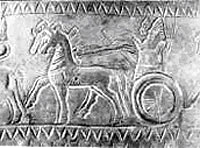Sarduri II on:
[Wikipedia]
[Google]
[Amazon]
 Sarduri II (ruled: 764–735 BC) was a
Sarduri II (ruled: 764–735 BC) was a
 The following are two passages from Sarduri II's inscriptions found at Van by Armenian archeologist Joseph Orbeli in 1912:
Claims of conquests such as this appear repeatedly:
The following are two passages from Sarduri II's inscriptions found at Van by Armenian archeologist Joseph Orbeli in 1912:
Claims of conquests such as this appear repeatedly:
Chapter 8: ""Sarduri II (753-735 BC): The Golden Age of Vannic power
Kings of Urartu 8th-century BC monarchs {{ANE-bio-stub
King
King is a royal title given to a male monarch. A king is an Absolute monarchy, absolute monarch if he holds unrestricted Government, governmental power or exercises full sovereignty over a nation. Conversely, he is a Constitutional monarchy, ...
of Urartu
Urartu was an Iron Age kingdom centered around the Armenian highlands between Lake Van, Lake Urmia, and Lake Sevan. The territory of the ancient kingdom of Urartu extended over the modern frontiers of Turkey, Iran, Iraq, and Armenia.Kleiss, Wo ...
, succeeding his father Argishti I to the throne. The Urartian Kingdom was at its peak during his reign, campaigning successfully against several neighbouring powers, including Assyria
Assyria (Neo-Assyrian cuneiform: , ''māt Aššur'') was a major ancient Mesopotamian civilization that existed as a city-state from the 21st century BC to the 14th century BC and eventually expanded into an empire from the 14th century BC t ...
.
Reign
The succession from Sarduri II is not entirely clear. There's also attested a king Sarduri III, so Rusa may also have been his son. Sarduri II notably expanded Urartian territory by conquering the northern region ofColchis
In classical antiquity and Greco-Roman geography, Colchis (; ) was an exonym for the Georgian polity of Egrisi ( ka, ეგრისი) located on the eastern coast of the Black Sea, centered in present-day western Georgia.
Its population, the ...
, as well as Melid
Arslantepe, also known as Melid, was an ancient city on the Tohma River, a tributary of the upper Euphrates rising in the Taurus Mountains. It has been identified with the modern archaeological site of Arslantepe near Malatya, Turkey.
It was na ...
and Kummuh in the Euphrates
The Euphrates ( ; see #Etymology, below) is the longest and one of the most historically important rivers of West Asia. Tigris–Euphrates river system, Together with the Tigris, it is one of the two defining rivers of Mesopotamia (). Originati ...
valley. Urartian sources refer to campaigns of Sarduri II against a place called "Babilu", which has sometimes been identified with Kassite regions that were formerly part of Babylonian Empire
In 743 BC, at a battle located somewhere in Kummuh, the Assyrians, under Tiglath-pileser III, defeated Sarduri and his anti-Assyrian coalition, forcing the Urartians back across the Euphrates.
Sarduri II was so confident in his power that he erected a massive wall at Tushpa (modern-day Van) with the following inscription:
He may also have been succeeded by his son, Rusa I. There are various theories about this, but the matter is still disputed because of the lack of solid evidence. Kayalıdere castle is one of the important checkpoints built during the reign of the king of Urartu.
Early campaigns
 The following are two passages from Sarduri II's inscriptions found at Van by Armenian archeologist Joseph Orbeli in 1912:
Claims of conquests such as this appear repeatedly:
The following are two passages from Sarduri II's inscriptions found at Van by Armenian archeologist Joseph Orbeli in 1912:
Claims of conquests such as this appear repeatedly:
See also
*List of kings of Urartu
This article lists the kings of Urartu (Ararat or Kingdom of Van), an Iron Age kingdom centered on Lake Van in eastern Asia Minor.
Kings
See also
*List of Mesopotamian dynasties
References
*Boris Piotrovskii, ''The Ancient Civilization of Ura ...
References
*M. Chahin (2001) "The Kingdom of Armenia",Chapter 8: ""Sarduri II (753-735 BC): The Golden Age of Vannic power
Kings of Urartu 8th-century BC monarchs {{ANE-bio-stub